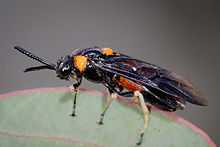Sawfly
| Sawfly Temporal range: Triassic - Recent | |
|---|---|
 | |
| Melaleuca species sawfly | |
| Scientific classification | |
| Kingdom: | Animalia |
| Phylum: | Arthropoda |
| Class: | Insecta |
| Order: | Hymenoptera |
| Suborder: | Symphyta |
| Superfamilies and families | |
|
Superfamily Cephoidea | |
Sawfly is the common name for insects belonging to suborder Symphyta of the order Hymenoptera. Sawflies are distinguishable from most other Hymenoptera by the broad connection between the abdomen and the thorax, and by their caterpillar-like larvae. The common name comes from the saw-like appearance of the ovipositor, which the females use to cut into the plants where they lay their eggs. Large populations of certain sawfly species can cause substantial economic damage to forests and cultivated plants.
Taxonomy

Sawflies are a group of largely phytophagous (herbivorous) insects. The overall group is paraphyletic, but the name is still in common use, and treated as a suborder, though it seems likely it will be phased out in future classifications. These superfamilies are regarded as the most primitive taxa within the Hymenoptera (some going back 200 million years), and one of the taxa within the Symphyta gave rise to the suborder Apocrita (wasps, bees and ants - this group is considered monophyletic). In the opinion of many experts, the most likely sister taxon to the Apocrita is the family Orussidae, the only Symphytan group which is parasitic.
Larvae


The larvae look like caterpillars (the larvae of moths and butterflies), with two notable exceptions; (1) they have six or more pairs of prolegs on the abdomen (caterpillars have five or fewer), and (2) they have two stemmata instead of a caterpillar's six. Typical sawfly larvae are herbivorous, the group feeding on a wide range of plants. Individual species, however, are often quite specific in their choice of plants used for food. The larvae of various species exhibit leaf-mining, leaf "rolling", or gall formation. Three families are strictly xylophagous, and called "wood wasps", and one family is parasitic. The larvae that do not feed externally on plants are grub-like, without prolegs.
.jpg)
Adults

Adults also have stronger antennae.
See also
References
- The American Museum of Natural History 2004-01-15
- Kendall Bioresearch Services (Image)
External links
| Wikispecies has information related to: Symphyta |
| Wikimedia Commons has media related to Symphyta. |
- ECatSym - Electronic World Catalog of Symphyta
- Sawfly - Tenthredininae subfamily - diagnostic photographs and information
- Sawfly - Dolerus unicolor photos and information
- Sawfly - Dolerus nitens photographs
- Sawfly Arge humeralis photographs
- A sawfly injurious to young pines hosted by the UNT Government Documents Department
| |||||||||||||||||||||||||||||||||||||||||||||||||||||||||||||||||||||||||||||||||||